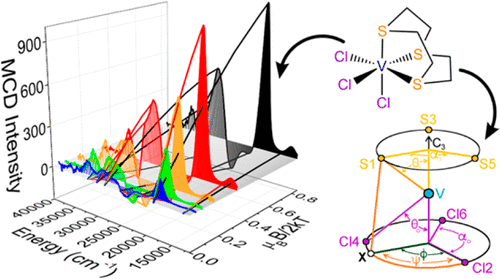当前位置:
X-MOL 学术
›
Inorg. Chem.
›
论文详情
Our official English website, www.x-mol.net, welcomes your
feedback! (Note: you will need to create a separate account there.)
Investigations of the Magnetic and Spectroscopic Properties of V(III) and V(IV) Complexes
Inorganic Chemistry ( IF 4.3 ) Pub Date : 2018-05-23 00:00:00 , DOI: 10.1021/acs.inorgchem.8b00486 Casey Van Stappen 1 , Dimitrios Maganas 2 , Serena DeBeer 1 , Eckhard Bill 2 , Frank Neese 2
Inorganic Chemistry ( IF 4.3 ) Pub Date : 2018-05-23 00:00:00 , DOI: 10.1021/acs.inorgchem.8b00486 Casey Van Stappen 1 , Dimitrios Maganas 2 , Serena DeBeer 1 , Eckhard Bill 2 , Frank Neese 2
Affiliation

|
Herein, we utilize a variety of physical methods including magnetometry (SQUID), electron paramagnetic resonance (EPR), and magnetic circular dichroism (MCD), in conjunction with high-level ab initio theory to probe both the ground and ligand-field excited electronic states of a series of V(IV) (S = 1/2) and V(III) (S = 1) molecular complexes. The ligand fields of the central metal ions are analyzed with the aid of ab initio ligand-field theory (AILFT), which allows for a chemically meaningful interpretation of multireference electronic structure calculations at the level of the complete-active-space self-consistent field with second-order N-electron valence perturbation theory. Our calculations are in good agreement with all experimentally investigated observables (magnetic properties, EPR, and MCD), making our extracted ligand-field theory parameters realistic. The ligand fields predicted by AILFT are further analyzed with conventional angular overlap parametrization, allowing the ligand field to be decomposed into individual σ- and π-donor contributions from individual ligands. The results demonstrate in VO2+ complexes that while the axial vanadium–oxo interaction dominates both the ground- and excited-state properties of vanadyl complexes, proximal coordination can significantly modulate the vanadyl bond covalency. Similarly, the electronic properties of V(III) complexes are particularly sensitive to the available σ and π interactions with the surrounding ligands. The results of this study demonstrate the power of AILFT-based analysis and provide the groundwork for the future analysis of vanadium centers in homogeneous and heterogeneous catalysts.
中文翻译:

V(III)和V(IV)配合物的磁性和光谱性质的研究
在本文中,我们利用各种物理方法,包括磁力计(SQUID),电子顺磁共振(EPR)和磁圆二向色性(MCD),并结合高级从头算原理,来探究地面和配体场激发电子一系列V(IV)(的状态小号= 1 / 2)和V(III)(小号= 1)分子配合物。从头算起的配体场理论(AILFT)来分析中心金属离子的配体场,该理论允许在完全活性空间自洽场的水平上对多参考电子结构计算进行化学上有意义的解释用二阶N电子价态扰动理论 我们的计算与所有实验研究的可观测值(磁性能,EPR和MCD)都非常吻合,从而使我们提取的配体场理论参数具有现实意义。通过AILFT预测的配体场可通过常规的角度重叠参数化进一步分析,从而使配体场可分解为来自各个配体的各个σ和π供体。结果在VO 2+中得到证明钒钒氧基的轴向相互作用主要控制钒基络合物的基态和激发态性质,而近端配位可以显着调节钒基键的共价。同样,V(III)配合物的电子性质对与周围配体的可用σ和π相互作用特别敏感。这项研究的结果证明了基于AILFT的分析的力量,并为将来在均相和非均相催化剂中钒中心的分析提供了基础。
更新日期:2018-05-23
中文翻译:

V(III)和V(IV)配合物的磁性和光谱性质的研究
在本文中,我们利用各种物理方法,包括磁力计(SQUID),电子顺磁共振(EPR)和磁圆二向色性(MCD),并结合高级从头算原理,来探究地面和配体场激发电子一系列V(IV)(的状态小号= 1 / 2)和V(III)(小号= 1)分子配合物。从头算起的配体场理论(AILFT)来分析中心金属离子的配体场,该理论允许在完全活性空间自洽场的水平上对多参考电子结构计算进行化学上有意义的解释用二阶N电子价态扰动理论 我们的计算与所有实验研究的可观测值(磁性能,EPR和MCD)都非常吻合,从而使我们提取的配体场理论参数具有现实意义。通过AILFT预测的配体场可通过常规的角度重叠参数化进一步分析,从而使配体场可分解为来自各个配体的各个σ和π供体。结果在VO 2+中得到证明钒钒氧基的轴向相互作用主要控制钒基络合物的基态和激发态性质,而近端配位可以显着调节钒基键的共价。同样,V(III)配合物的电子性质对与周围配体的可用σ和π相互作用特别敏感。这项研究的结果证明了基于AILFT的分析的力量,并为将来在均相和非均相催化剂中钒中心的分析提供了基础。











































 京公网安备 11010802027423号
京公网安备 11010802027423号